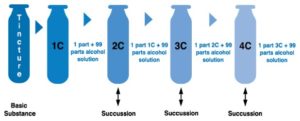Why is alcohol an inactive ingredient in Boiron’s liquid dose medicines?
Boiron’s liquid doses contain a small quantity of alcohol which is extremely low and presents no risk of adverse effects to babies or other young individuals of small weight. It is less than the alcohol amount that occurs naturally in some foods, including apple juice.1 Alcohol is not an added ingredient, but originates from the liquid tincture of the homeopathic medicines. Pure pharmaceutical grade ethanol (USP) is used in our manufacturing, which is derived from sugar beets and safe for human consumption. Neither the product’s formula nor Boiron’s manufacturing process have changed; however, labels and packaging are frequently updated to comply with regulations.
- Gorgus, Eva, Maike Hittinger, and Dieter Schrenk. “Estimates of Ethanol Exposure in Children from Food Not Labeled as Alcohol-Containing.” Journal of analytical toxicology. Oxford University Press, September 2016. https://www.ncbi.nlm.nih.gov/pmc/articles/PMC5421578/.
Why is alcohol an inactive ingredient in Optique 1?
Optique 1 contains a very small amount of alcohol (0.00915%), which is extremely low and presents no risk of adverse effects to the eyes. It is not an added ingredient but originates from the liquid tincture of homeopathic medicines. Neither the product’s formula nor Boiron’s manufacturing process has changed; however, labels and packaging are frequently updated to comply with regulations.
What is the typical dosage for a Boiron single medicine?
The standard dosage for any of our single medicines is five (5) pellets dissolved under the tongue, three (3) times a day, or consult the Boiron Medicine Finder app for the appropriate protocol based on your condition.
If after three days you show no improvement, we recommend consulting your health care professional. If your symptoms improve and you would like to take the medicine for a longer period of time, please consult your health care professional. If you have been given alternate dosage instructions by your health care professional, follow those instructions, as they have been developed specifically for your individual treatment.
My Blue Tube does not list the symptom I am experiencing. Am I taking the right medicine?
In homeopathy, the same single medicine may be useful for several different conditions. For example, Gelsemium 30C can be indicated for stress or fever, and Sepia 6C can be indicated for lower back pain during menstruation or hot flashes.*
Due to the small size of the containers, we print the most widely used indications that are suitable for self-medication of acute, self-limiting conditions. Therefore, the condition for which your doctor prescribed the medicine may not be listed on the tube.
How do I dispense the pellets from the multidose tube (also known as a Blue Tube)?
To dispense the pellets from the multidose tube, first turn the tube upside down with the cap on, then twist. As you twist, the pellets will fall into the cap. Continue twisting until the required number of pellets is in the cap. Remove the cap from the tube and use it to pour the pellets under your tongue.
https://www.youtube.com/watch?v=JPKgL-EOI8o&ab_channel=BoironUSA
What is the difference in dilution levels?
Most single homeopathic medicines are available in several dilutions. The letter indicates which dilution process was chosen, while the number indicates how many times that dilution process was used, and consequently, which symptoms the medicine is meant to treat.
Here's a quick guide to using homeopathic medicines: Low dilutions, such as 6X or 6C, will relieve local symptoms — a symptom you can point a finger at (e.g., an insect bite or bruise). Medium dilutions, such as 12X, 9C or 12C, will relieve general symptoms — more than one symptom in more than one location (e.g., muscle aches and pains). High dilutions, such as 30X or 30C, will relieve general symptoms — more than one symptom in more than one location with possible behavioral or emotional symptoms (e.g., a very high fever and chills, accompanied by agitation or sleeplessness).
If a person has the right medicine, no matter what the dilution, they will see a lessening of symptoms. For most medicines, choosing the right dilution is merely fine-tuning. It may be helpful for you to use the Boiron Medicine Finder app to help select which medicines and dilutions are best to relieve your symptoms.
What is a homeopathic dilution?
A homeopathic medicine is obtained from a precise and controlled process of successive homeopathic dilutions. With each homeopathic dilution, the medicine is deconcentrated and then vigorously shaken (also called “succussion”). This process transforms the original solution into a therapeutically active medicine.

What is homeopathy? What are homeopathic medicines?
Homeopathy is a therapeutic method that uses diluted extracts of natural substances to relieve symptoms. The active ingredients in homeopathic medicines include plants, animals, or minerals that relieve the same symptoms they cause at full strength (e.g., a microdose of coffee bean helps to relieve nervousness).
Homeopathic medicines have been used for more than 200 years. They are manufactured in strict accordance with the Homeopathic Pharmacopoeia of the United States (HPUS) and U.S. Food and Drug Administration regulations. Today, homeopathic medicines are used by millions of families and recommended by health care professionals around the world to relieve many common, everyday conditions such as allergies, coughs, colds, flu, stress, muscle pain, and teething.
Is there any scientific research on homeopathy?
An increasing number of scientific studies on homeopathic medicines are being conducted and published in peer-review journals. Clinical research is providing evidence of the efficacy of homeopathic medicines, and basic laboratory research is confirming the biological activity of highly diluted substances and helping the scientific community better understand their mechanism of action.
